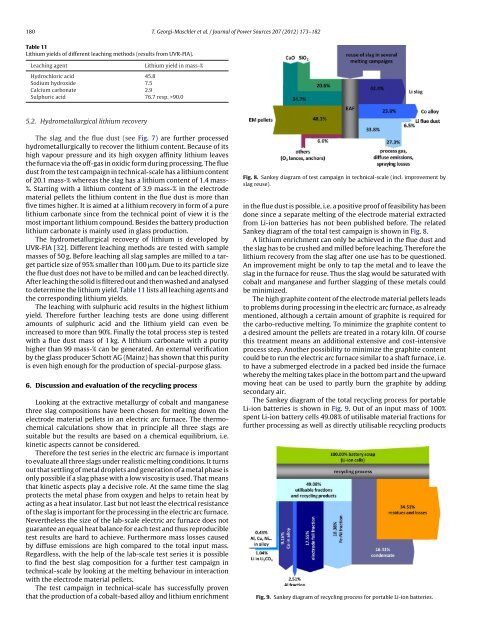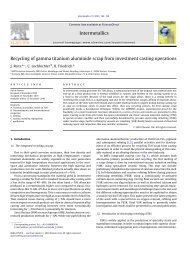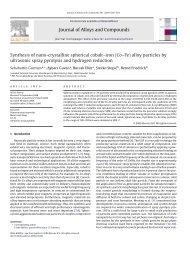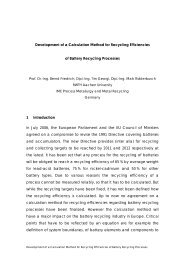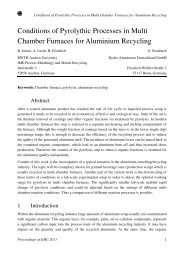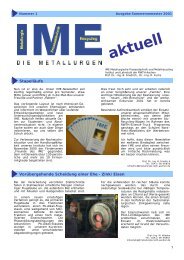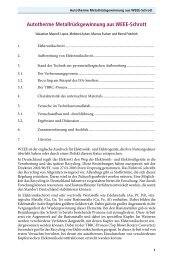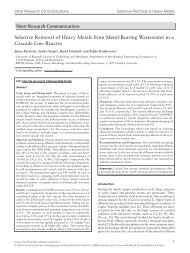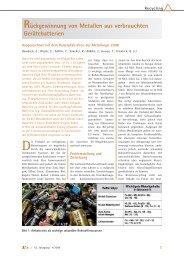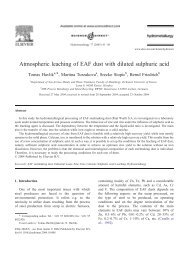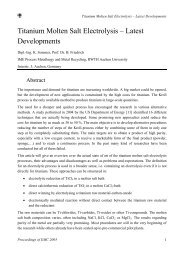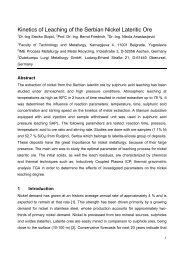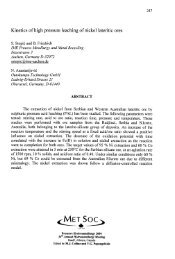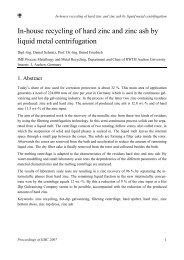Development of a recycling process for Li-ion batteries
Development of a recycling process for Li-ion batteries
Development of a recycling process for Li-ion batteries
- No tags were found...
Create successful ePaper yourself
Turn your PDF publications into a flip-book with our unique Google optimized e-Paper software.
180 T. Georgi-Maschler et al. / Journal <strong>of</strong> Power Sources 207 (2012) 173–182<br />
Table 11<br />
<strong>Li</strong>thium yields <strong>of</strong> different leaching methods (results from UVR-FIA).<br />
Leaching agent <strong>Li</strong>thium yield in mass-%<br />
Hydrochloric acid 45.8<br />
Sodium hydroxide 7.5<br />
Calcium carbonate 2.9<br />
Sulphuric acid 76.7 resp. >90.0<br />
5.2. Hydrometallurgical lithium recovery<br />
The slag and the flue dust (see Fig. 7) are further <strong>process</strong>ed<br />
hydrometallurgically to recover the lithium content. Because <strong>of</strong> its<br />
high vapour pressure and its high oxygen affinity lithium leaves<br />
the furnace via the <strong>of</strong>f-gas in oxidic <strong>for</strong>m during <strong>process</strong>ing. The flue<br />
dust from the test campaign in technical-scale has a lithium content<br />
<strong>of</strong> 20.1 mass-% whereas the slag has a lithium content <strong>of</strong> 1.4 mass-<br />
%. Starting with a lithium content <strong>of</strong> 3.9 mass-% in the electrode<br />
material pellets the lithium content in the flue dust is more than<br />
five times higher. It is aimed at a lithium recovery in <strong>for</strong>m <strong>of</strong> a pure<br />
lithium carbonate since from the technical point <strong>of</strong> view it is the<br />
most important lithium compound. Besides the battery product<strong>ion</strong><br />
lithium carbonate is mainly used in glass product<strong>ion</strong>.<br />
The hydrometallurgical recovery <strong>of</strong> lithium is developed by<br />
UVR-FIA [32]. Different leaching methods are tested with sample<br />
masses <strong>of</strong> 50 g. Be<strong>for</strong>e leaching all slag samples are milled to a target<br />
particle size <strong>of</strong> 95% smaller than 100 m. Due to its particle size<br />
the flue dust does not have to be milled and can be leached directly.<br />
After leaching the solid is filtered out and then washed and analysed<br />
to determine the lithium yield. Table 11 lists all leaching agents and<br />
the corresponding lithium yields.<br />
The leaching with sulphuric acid results in the highest lithium<br />
yield. There<strong>for</strong>e further leaching tests are done using different<br />
amounts <strong>of</strong> sulphuric acid and the lithium yield can even be<br />
increased to more than 90%. Finally the total <strong>process</strong> step is tested<br />
with a flue dust mass <strong>of</strong> 1 kg. A lithium carbonate with a purity<br />
higher than 99 mass-% can be generated. An external verificat<strong>ion</strong><br />
by the glass producer Schott AG (Mainz) has shown that this purity<br />
is even high enough <strong>for</strong> the product<strong>ion</strong> <strong>of</strong> special-purpose glass.<br />
6. Discuss<strong>ion</strong> and evaluat<strong>ion</strong> <strong>of</strong> the <strong>recycling</strong> <strong>process</strong><br />
Looking at the extractive metallurgy <strong>of</strong> cobalt and manganese<br />
three slag composit<strong>ion</strong>s have been chosen <strong>for</strong> melting down the<br />
electrode material pellets in an electric arc furnace. The thermochemical<br />
calculat<strong>ion</strong>s show that in principle all three slags are<br />
suitable but the results are based on a chemical equilibrium, i.e.<br />
kinetic aspects cannot be considered.<br />
There<strong>for</strong>e the test series in the electric arc furnace is important<br />
to evaluate all three slags under realistic melting condit<strong>ion</strong>s. It turns<br />
out that settling <strong>of</strong> metal droplets and generat<strong>ion</strong> <strong>of</strong> a metal phase is<br />
only possible if a slag phase with a low viscosity is used. That means<br />
that kinetic aspects play a decisive role. At the same time the slag<br />
protects the metal phase from oxygen and helps to retain heat by<br />
acting as a heat insulator. Last but not least the electrical resistance<br />
<strong>of</strong> the slag is important <strong>for</strong> the <strong>process</strong>ing in the electric arc furnace.<br />
Nevertheless the size <strong>of</strong> the lab-scale electric arc furnace does not<br />
guarantee an equal heat balance <strong>for</strong> each test and thus reproducible<br />
test results are hard to achieve. Furthermore mass losses caused<br />
by diffuse emiss<strong>ion</strong>s are high compared to the total input mass.<br />
Regardless, with the help <strong>of</strong> the lab-scale test series it is possible<br />
to find the best slag composit<strong>ion</strong> <strong>for</strong> a further test campaign in<br />
technical-scale by looking at the melting behaviour in interact<strong>ion</strong><br />
with the electrode material pellets.<br />
The test campaign in technical-scale has successfully proven<br />
that the product<strong>ion</strong> <strong>of</strong> a cobalt-based alloy and lithium enrichment<br />
Fig. 8. Sankey diagram <strong>of</strong> test campaign in technical-scale (incl. improvement by<br />
slag reuse).<br />
in the flue dust is possible, i.e. a positive pro<strong>of</strong> <strong>of</strong> feasibility has been<br />
done since a separate melting <strong>of</strong> the electrode material extracted<br />
from <strong>Li</strong>-<strong>ion</strong> <strong>batteries</strong> has not been published be<strong>for</strong>e. The related<br />
Sankey diagram <strong>of</strong> the total test campaign is shown in Fig. 8.<br />
A lithium enrichment can only be achieved in the flue dust and<br />
the slag has to be crushed and milled be<strong>for</strong>e leaching. There<strong>for</strong>e the<br />
lithium recovery from the slag after one use has to be quest<strong>ion</strong>ed.<br />
An improvement might be only to tap the metal and to leave the<br />
slag in the furnace <strong>for</strong> reuse. Thus the slag would be saturated with<br />
cobalt and manganese and further slagging <strong>of</strong> these metals could<br />
be minimized.<br />
The high graphite content <strong>of</strong> the electrode material pellets leads<br />
to problems during <strong>process</strong>ing in the electric arc furnace, as already<br />
ment<strong>ion</strong>ed, although a certain amount <strong>of</strong> graphite is required <strong>for</strong><br />
the carbo-reductive melting. To minimize the graphite content to<br />
a desired amount the pellets are treated in a rotary kiln. Of course<br />
this treatment means an addit<strong>ion</strong>al extensive and cost-intensive<br />
<strong>process</strong> step. Another possibility to minimize the graphite content<br />
could be to run the electric arc furnace similar to a shaft furnace, i.e.<br />
to have a submerged electrode in a packed bed inside the furnace<br />
whereby the melting takes place in the bottom part and the upward<br />
moving heat can be used to partly burn the graphite by adding<br />
secondary air.<br />
The Sankey diagram <strong>of</strong> the total <strong>recycling</strong> <strong>process</strong> <strong>for</strong> portable<br />
<strong>Li</strong>-<strong>ion</strong> <strong>batteries</strong> is shown in Fig. 9. Out <strong>of</strong> an input mass <strong>of</strong> 100%<br />
spent <strong>Li</strong>-<strong>ion</strong> battery cells 49.08% <strong>of</strong> utilisable material fract<strong>ion</strong>s <strong>for</strong><br />
further <strong>process</strong>ing as well as directly utilisable <strong>recycling</strong> products<br />
Fig. 9. Sankey diagram <strong>of</strong> <strong>recycling</strong> <strong>process</strong> <strong>for</strong> portable <strong>Li</strong>-<strong>ion</strong> <strong>batteries</strong>.


